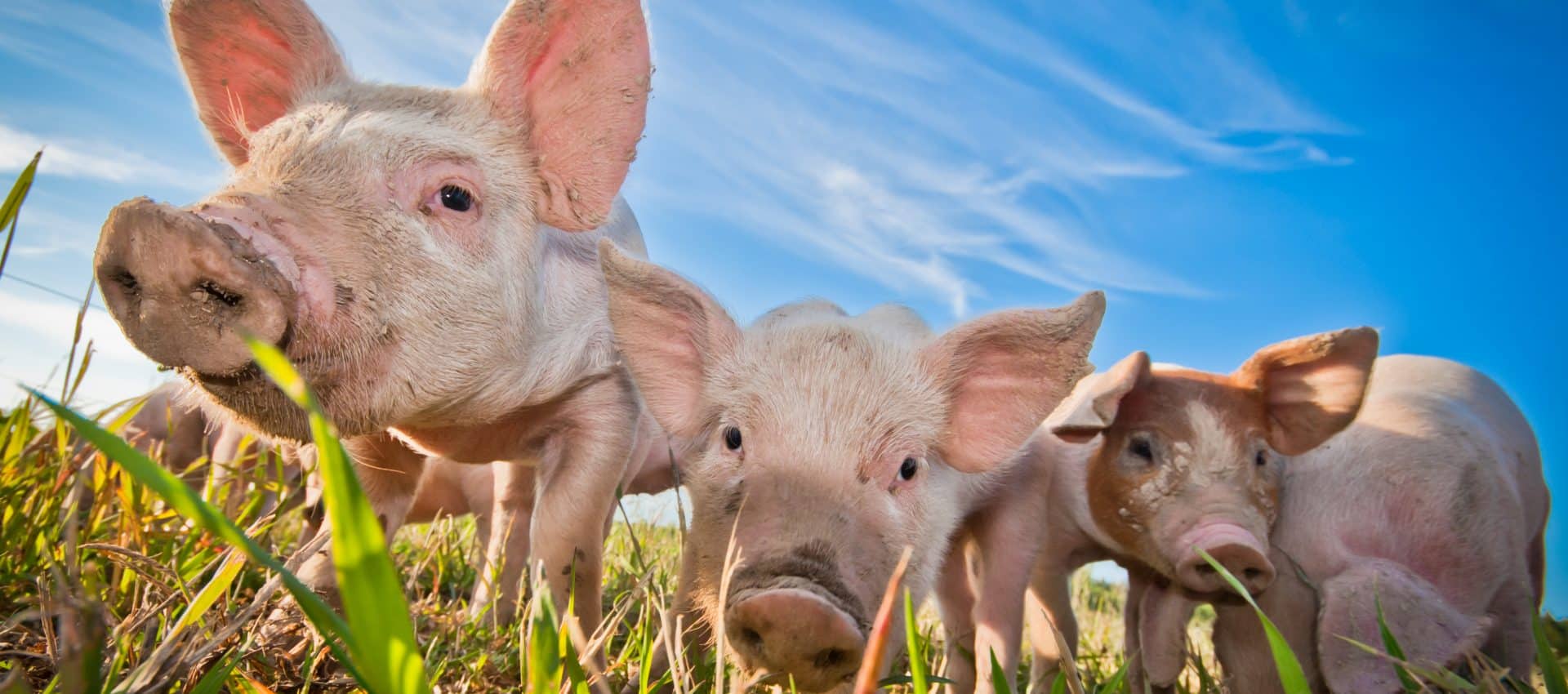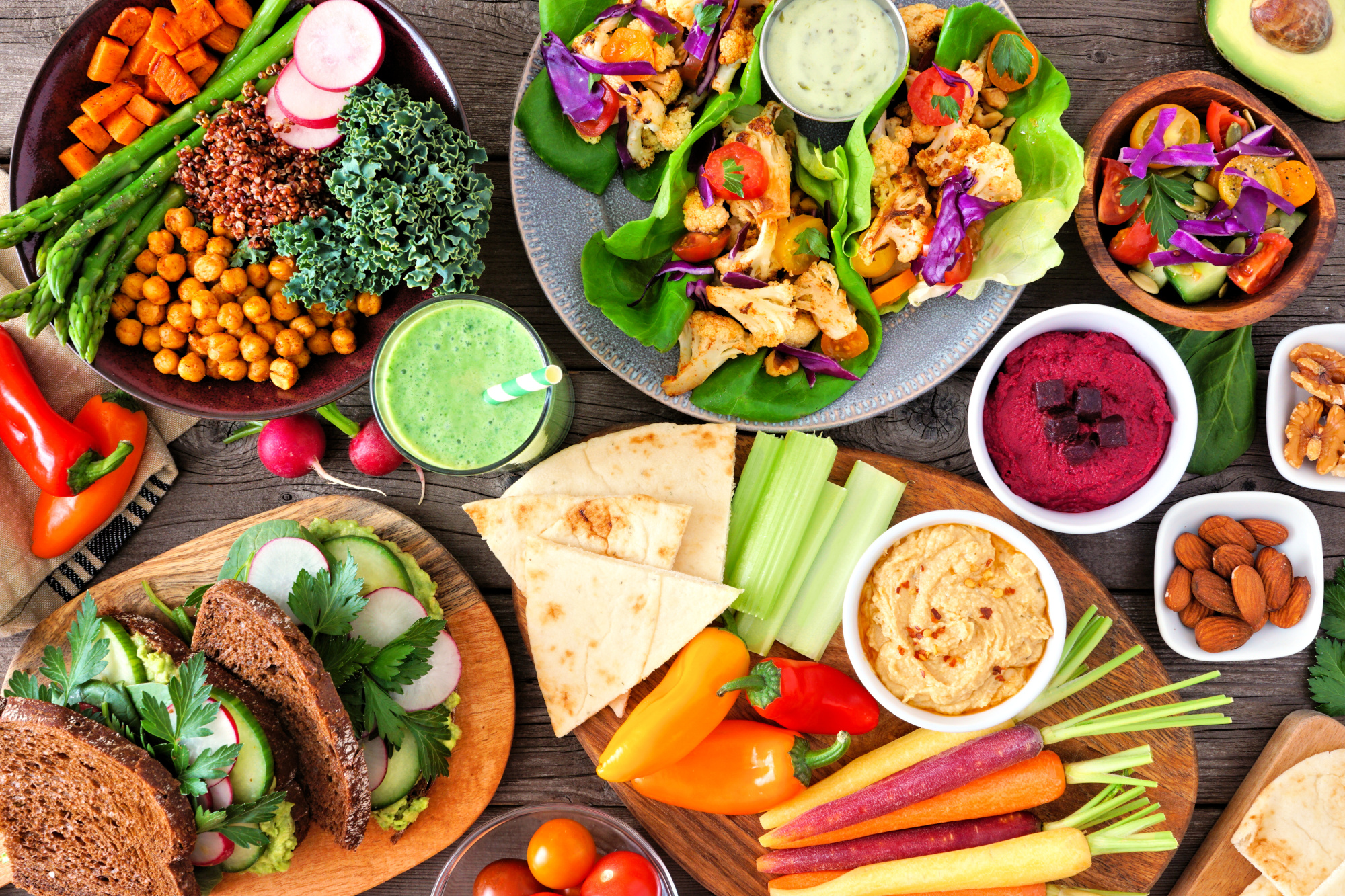Although pigs are among the most intelligent animals and pork is the most consumed meat in the world, the lives and deaths of pigs in factory farms remain invisible to consumers. ProVeg takes a look at the social lives of pigs and the practices of pig farms and draws attention to delicious alternatives to pork.
The basic needs of pigs
Wild pigs’ natural habitat is forests, where they forage for food and find shelter beneath bushes and trees.1 Female pigs and their young form hierarchical groups, which ensures their peaceful coexistence.2 Each group occupies a defined territory and is led by the oldest, most experienced sow.3 Pigs are very social animals – they establish lifelong friendships and communicate with each other in a variety of ways. So far, more than 20 different vocalisations have been decoded. Although pigs are omnivores, they show a preference for roots, fruit, and vegetables.4
Pigs are intelligent, empathetic, and playful individuals
Pigs are very curious about their environment, using their snouts and teeth to explore their surroundings. In terms of intelligence, they rival both dogs and cats. Pigs learn significantly faster than dogs and can remember more commands. They are, for example, able to complete complex tasks, and can learn words as well as entire sentences. Pigs can easily compete with chimpanzees at computer games and have a far better ability to concentrate on them.5 6
Furthermore, pigs are able to recognise themselves in mirrors, indicating a capacity for self-awareness.7 They are capable of abstract thought, remember what they learn for years after, and are able to work as a team. They also have an astonishing sense of empathy, can feel compassion for their fellow pigs, and, like humans, they are able to deliberately deceive others.8 9
Sows lovingly care for their young
Sows are loving and caring mothers. Under natural conditions, towards the end of her four-month pregnancy, a sow will collect a variety of materials in order to build a nest for her young.10 11 Mother sows are highly attentive and protective of their offspring. When their piglets start wandering out of sight, the mothers call out to them continuously in order to stay in contact. Piglets spend hours playing with each other, and even adult pigs display similar playful behaviour.
Pigs are very cleanly
Contrary to popular belief, pigs are tidy individuals and have strictly separated areas for sleeping, eating, and defecating. Because their extremities are not made for grooming, they groom each other and rub themselves against suitable objects such as tree stumps. Pigs do not sweat, which is why they like to swim or cool off with a mud bath.12 A coat of dried mud also protects their skin from sunburn and insects.
Living conditions on pig factory farms
About 1 billion pigs currently live on commercial farms around the world. China, the United States, and Germany are among the world’s top pork producers.13 Both male and female pigs are fed until their ‘carcass weight’ reaches 110 to 125 kg – usually within six months.14 15 This rapid growth is due mainly to three factors: their movement is severely restricted, they are fed calorie-dense foods, and they are selectively bred to grow as fast as possible, all of which impact negatively on their health.
Pigs in European factory farms spend their entire lives in a space that is smaller than a square metre,16 barely enough room to turn around or lie down. They are kept on concrete floors, with slatted crevices allowing faeces and urine to pass through. On Europe’s organic farms, pigs fare only slightly better: They are allowed 1.3 m² of indoor space and an additional 1 m² outdoors, which is usually a concrete floor sparsely covered with straw.17 Compared to a natural environment, conditions on industrial farms offer little external stimulus for the pigs. Because their natural inquisitiveness is met with sensory deprivation, pigs in these conditions often become so stressed that they are driven to cannibalism of their group-mates.
Pig breeding
For at least one month during the ‘insemination phase’, sows are kept separate from their fellow pigs in so-called gestation crates. These crates are just slightly larger than the sows themselves. Afterwards, they are returned to the group, but regulations allow for them to be kept in further isolation.
A week before giving birth (or farrowing, to use the technical term), the mother sow is moved to a farrowing crate. Like gestation crates, farrowing crates are metal cages so narrow that the sows cannot even turn around. Mothers and their piglets generally remain in these bedding-less farrowing crates for about four weeks. When her piglets are taken away, the mother is immediately returned to a gestation crate, where she will be inseminated again a mere five days later.18
Standard piglet mutilation procedures
Shortly after birth, piglets endure several mutilation procedures, usually performed without anaesthetic. Among the most painful of these are castration, tail docking, and the grinding down of their teeth. All these procedures are necessitated by the unnatural and severely restrictive husbandry conditions that are used in industrial pig farming.
Castration of piglets
All male piglets are castrated shortly after birth since the meat of uncastrated male pigs can develop an unpleasant odour referred to as ‘boar taint’.19 If done within the first seven days after birth, European law allows this procedure to be performed without anaesthetic.20
Tail docking
To prevent tail biting, it is common for piglets to have their characteristically curly tails cut off within three days after being born. Not only is this procedure performed without anaesthetic, it can also lead to chronic pain and long-term health consequences.21 If the piglets are younger than eight days, such a procedure can legally be done in the EU without anaesthetic.22
Tooth grinding
The non-anaesthetised grinding down of piglets’ teeth is supposed to prevent the mother’s teats from being injured. These injuries occur because the restrictive conditions in farrowing crates prevent the sow from moving her teats out of her piglets’ reach. During the piglets’ first eight days of life, this procedure can also be legally performed without anaesthetic.23
Pig slaughter
After about 18 weeks of fattening, at just six months old, the pigs are loaded onto overcrowded trucks and transported long distances to be slaughtered. At the slaughterhouse, a gas or electric shock is administered to render the pigs unconscious before killing. In Germany, the failure rate for stunning is 12%, and in the UK it is as high as 20%.24 25 In these cases, pigs consciously experience their throats being slit and are left to bleed out. A small percentage remain conscious past this point, and can then feel their bodies being lowered into scalding 60°C water.
The risks of pork consumption
Almost 1.5 billion pigs are bred, fattened, and slaughtered every year. Globally, pork is one of the most consumed meats. In 2013, the average person ate approximately 16 kg of pork. In the US, the per capita consumption is 28 kg, while in Europe, it is 39 kg.26 Plant-based alternatives to pork have a positive impact on both the environment and our health.
Regularly occurring food scandals such as swine flu and rotten meat, and the increasing occurrence of multidrug-resistant pathogens, exacerbated by the high use of antibiotics, are just a few examples of the health risks that animal-based foods can pose. Meat consumption is also a risk factor for diseases of the cardiovascular system. A US study, with more than 500,000 participants, showed that, compared to people consuming the least meat, men with the highest meat consumption were 27% more likely to die of cardiovascular disease, whereas for women the risk was elevated by 50%.27 The more red and processed meat that was eaten, the greater the risk became.
Meat alternatives are growing in popularity
More and more consumers are questioning the consumption of meat and the effects that our diets have on animals, the environment, and our health. This is also reflected in the increasing demand for meat substitutes. All well-known supermarkets now offer a wide range of plant-based burgers, sausages, and more, based on legumes, vegetables, cereals, and other ingredients. Meat alternatives offer several advantages compared to meat. Vegan versions of burgers, for example, are free of cholesterol und usually contain fewer calories and less fat than similar burgers made from meat.
ProVeg presents the best plant-based meat alternatives.
ProVeg supports the availability of plant-based meat alternatives
ProVeg does not only point out healthy, cruelty-free alternatives but also makes them more readily available. ProVeg supports and facilitates a range of vegan events throughout the year, from annual happenings such as VeggieWorld and VegMed to important one-off events such as CEVA trainings and legal and political symposiums. Furthermore, the ProVeg Incubator advises and supports innovative companies that want to enrich the veggie market with their products. This ranges from mentoring early-stage start-ups to consulting for major international supermarket brands and administering the V-Label, which guarantees that a product is either vegan or vegetarian. Find out more about what we are doing to help the world transition to a more plant-based society and economy that are sustainable for humans, animals, and our planet.
References
- Leaper R, G. Massei, M. L. Gorman & R. Aspinall (1999): The feasibility of reintroducing wild boar (Sus scrofa) to Scotland. Mammal Review 29(4):239-59. Available at http://www.blackwellpublishing.com/specialarticles/mam1_xx.pdf [03.03.2018]
- Report of the Scientific Veterinary Committee (1997): The Welfare of Intensively Kept Pigs. European Commission. Available at https://ec.europa.eu/food/sites/food/files/animals/docs/aw_arch_1997_intensively_kept_pigs_en.pdf [03.03.2018]
- Hoy, S. (2009): Nutztierethologie. Verlag Eugen Ulmer, Stuttgart. p. 105
- Animal diversity Web: Sus Scrofa – Wild Boar. Available at http://animaldiversity.org/accounts/Sus_scrofa/#food_habits [03.03.2018]
- Marino L. & C. M. Colvin. Thinking Pigs: Cognition, Emotion, and Personality – An Exploration of the Cognitive Complexity of Sus Domesticus, the Domestic Pig. The Someone Project. Available at http://www.farmsanctuary.org/wp-content/uploads/2016/08/TSP_PIGS_WhitePaper.pdf [03.03.2018]
- Marino, L. & C. M. Colvin (2015): Thinking Pigs: A Comparative Review of Cognition, Emotion, and Personality in. International Journal of Comparative Psychology 28, no. 1 (January 1, 2015). Available at http://escholarship.org/uc/item/8sx4s79c [03.03.2018]
- Broom, D. M., H. Sena & K. L. Moynihan (2009): Pigs Learn What a Mirror Image Represents and Use It to Obtain Information. Animal Behaviour 78, no. 5 (November 2009): 1037–41. doi:10.1016/j.anbehav.2009.07.027.
- Marino, L. & C. M. Colvin (2015): Thinking Pigs: A Comparative Review of Cognition, Emotion, and Personality in. International Journal of Comparative Psychology 28, no. 1 (January 1, 2015). http://escholarship.org/uc/item/8sx4s79c.
- Marino L. & C. M. Colvin. Thinking Pigs: Cognition, Emotion, and Personality – An Exploration of the Cognitive Complexity of Sus Domesticus, the Domestic Pig. The Someone Project. Available at: http://www.farmsanctuary.org/wp-content/uploads/2016/08/TSP_PIGS_WhitePaper.pdf
- Report of the Scientific Veterinary Committee (1997): The Welfare of Intensively Kept Pigs. European Commission. Available at https://ec.europa.eu/food/sites/food/files/animals/docs/aw_arch_1997_intensively_kept_pigs_en.pdf [03.03.2018]
- Gundlach, H. (1968) Brutfürsorge, Brutpflege, Verhaltensontogenese und Tagesperiodik beim Europäischen Wildschwein ( Sus Scrofa, L.). Z Tierpsychol 25: 955-995.
- Report of the Scientific Veterinary Committee (1997): The Welfare of Intensively Kept Pigs. European Commission. Available at https://ec.europa.eu/food/sites/food/files/animals/docs/aw_arch_1997_intensively_kept_pigs_en.pdf [03.03.2018]
- Food and Agriculture Organization of the United Nations (2017). FAOSTAT Statistics Database. Available at http://www.fao.org/faostat/en/#data/QA [03.03.2018]
- Bundesanstalt für Landwirtschaft und Ernährung: Wann ist ein Schwein schlachtreif? Online unter https://www.ble.de/DE/BZL/Kennen-Sie-Landwirtschaft/Tier-Stall/Schwein-Schlachtreif.html?nn=9123528 [03.03.2018]
- Bayerische Landesanstalt für Landwirtschaft. Optimales Mastendgewicht bei Schweinen – Biologische Leistungen. Available at https://www.lfl.bayern.de/mam/cms07/ite/dateien/36201_optimale_mastendgewicht.pdf
- Council Directive 2008/120/EC of 18 December 2008 laying down minimum standards for the protection of pigs
- Commission Regulation (EC) No 889/2008 of 5 September 2008 laying down detailed rules for the implementation of Council Regulation (EC) No 834/2007 on organic production and labelling of organic products with regard to organic production, labelling and control
- Weiß, J. W., W. Pabst (Hrsg.) (2011): Tierproduktion. Stuttgart. 14. Aflage
- European Commission. Alternatives to pig castration. Available at http://ec.europa.eu/food/animals/welfare/practice/farm/pigs/castration_alternatives_en [03.03.2018]
- Council Directive 2008/120/EC of 18 December 2008 laying down minimum standards for the protection of pigs
- Simonsen, H.B., L. Klinken & E. Bindseil (1991): Histopathology of Intact and Docked Pigtails. British Veterinary Journal 147, no. 5 (September 1991): 407–12. doi:10.1016/0007-1935(91)90082-X.
- Council Directive 2008/120/EC of 18 December 2008 laying down minimum standards for the protection of pigs
- Council Directive 2008/120/EC of 18 December 2008 laying down minimum standards for the protection of pigs
- Spiegel Online (2012): Regierung rügt Tierquälerei in Schlachthöfen. Available at: http://www.spiegel.de/wissenschaft/natur/schlachthoefe-arbeiten-mit-hoher-fehlerquote-tiere-leiden-unnoetig-a-840156.html [03.03.2018]
- Anil, M.H. & McKinstry, J.L. (1993). Results of a survey of pig abattoirs in England & Wales. London: MAFF Meat Hygiene Division. Reciprocation
- Food and Agriculture Organization of the United Nations (2017). FAOSTAT Statistics Database. Available at http://www.fao.org/faostat/en/#data/FBS [03.03.2018]
- Sinha R, Cross AJ, Graubard BI, Leitzmann MF, Schatzkin A (2009): Meat intake and mortality: a prospective study of over half a million people. Arch Intern Med 169 (6), 562-71



